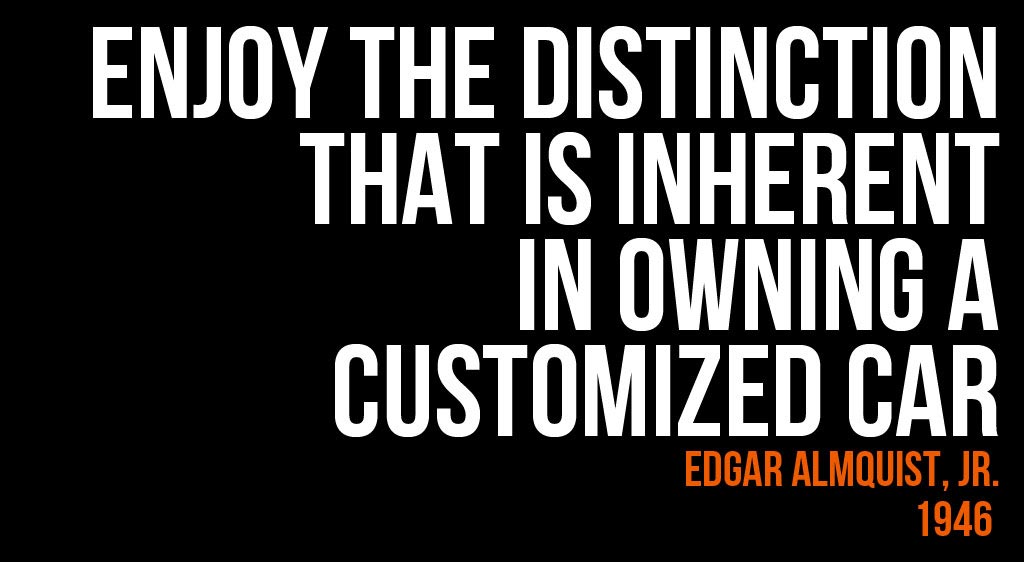Potvin Automotive
Potvin Automotive was operated by Chuck Potvin of Anaheim, California and was located on North Los Angeles Street and East Wilhelmina in Anaheim, California. Chuck was first introduced to the world of racing in the year of 1937. He and a buddy named Doug Hartelt was out rabbit-hunting at El Mirage Dry Lake, they were driven up for a weekend of camping and hunting. However, their shooting got attention from SCTA members who were holding a race meet in the same area. The young boys were asked if they could stop shooting, as a compensation for being asked to stop shooting, Chuck and Doug were offered to take their 1932 Ford roadster through the speed traps. This incident sparked the boys interest to racing, Doug would become a successful race driver and engine builder while Chuck opened his speed equipment shop. Chuck along with Doug, Dick Kraft, Kenny Lindley and the Palm brothers formed a car club named the Plutocrats while they attended Anaheim High School between 1935 and 1939. Ron Roseberry of R&L Chassis in Anaheim remembered that Chuck once told him how he got into designing camshafts, It was Chuck's high school shop teacher showed him the mathematical equations necessary for fundamental camshaft lobe design and the technical aspects of camshaft grinding. The club was disbanded after the graduation in 1940, instead they became members of the Hollywood Lancers, later known as just the Lancers.[1]
Chuck was a very gifted talent when it came to engines, in his late teen he managed to successfully modify his own ignition. The ignition worked very well, and soon other friends wanted one for their cars to. Before he was enlisted to serve in World War II, he was busy converting Zephyr ignitions in his parents garage on West Broadway in Anaheim. The Army found out from his tests that his technical skills were very high and assigned him to work on aircraft carburetion in the engine department of the Douglas Aircraft Company.[1]
After returning from the war in one piece, Chuck continued modifying ignitions behind his parents' home under the name of Potvin Engineering. Business was brisk due to the huge postwar surge in auto racing, in addition to the profitable ignition business, Chuck began distributing Evans Speed Equipment items. As the years passed by and the business grew, the shop in his parents backyard became to small, eventually Chuck moved his business in 1948 to North Los Angeles Street and East Wilhelmina in Anaheim where he had bought a corner lot. The block building was a little larger than a two-car garage, but it contained two camshaft grinders, Chuck's homemade master cam generator, a dynamometer, and several metal lathes. Chuck learned from the Douglas Aircraft Company that the only way to know the full potential if any engine was to hook it up to a dynamometer. The Dyno featured a flywheel and starter motor which Chuck added along with some heavy-duty mufflers to keep peace with the neighbors. [1]
Contents
Cam Grinding
By the mid-summer of 1948, Potvin Automotive was doing really well, Potvin had an advertisement in Hot Rod Magazine mentioning they were handling aluminum flywheels and Cromwell leather racing helmets in addition to the dual ignitions and Evans epquipment. Later on in the 1950's, Chuck advertised very little. Potvin could see that the performance camshaft field held good possibilities. By 1949, Chuck focused mainly on designing cams, he designed all the flathead cams he were selling and most of the flat-tappet cams. During his teenage years, his cars featured Pierre Bertrand cams and were satisfied with those grinds, he used a modified version of the Bertrand camshaft as a basis for his grind until he got a handle on the art of camshaft design. Chuck built his first cam grinder by using a Storm-Vulcan crankshaft grinder, he made up a rocking table and had Conze Machine Shop manufacture the intricate index plates. The rocking table allowed the camshaft to follow the shape of a master cam and make contact with the grinding wheel. Chuck made a dozens of flathead grinds, but the camshaft grind that made Potvin a synonymous with power was the fabulous 425 Eliminator. Many debates were made over which cam was the best, the Iskendrian 404 or the Potvin 425 Eliminator. According to Bill Jenks, the 404 cam had more midrange torque while the 425 had more upper-rpm. In a 1954 Potvin ad, it was stated that 65 percent of all the times turned in at drag strips in Southern California above 130 mph was Potvin-equipped cars. There was no time left for racing, so the cars of Doug Hartelt, Bill Jenks, George "Ollie" Morris and Otto Ryssman were usually testing out the latest cam designs. George Morris was the first to install a 425 cam in his rear engined dragster, the top speed Ollie achieved was 144,33 mph. The first car to break the 160 mph barrier in 1953 was Art and Lloyd Chrisman's 1930 Ford featuring a 425 Eliminator cam.[1]
Extracting Nitroglycerin
Otto Ryssman lived on an orange farm and was able to buy dynamite for land clearing purposes. Chuck would often have Otto buy a half-dozen cases of dynamite to extract nitroglycerin from. He would somehow safely heat up the dynamite, separating the nitro out of the dynamite sticks, he would then mix it together with alcohol and end up with a formula for a highly potent fuel. A life long friend of Chuck, Leslie Long recalls that in the early 1990's, the local news media reported that several cases of abandoned dynamite discovered in an old lady's garage in Anaheim, which was the same garage Chuck rented as a storage several years earlier.[1]
Potvin's Blower System
In the mid 1950's, many began to explore with GMC blowers. After the successes with Doug Hartelt's 1934 Ford, Chuck began realizing that it was a market for a setup of this style that provided a positive locked drive, better visibility, and a lower center of gravity. The set you could buy from GM was sold as a do-it-yourself kit that had to be welded together. Customers sent in blowers to Potvin, where they were inspected for any defects and fitted with an oil line for the drive gears. An engine adapter housing was then installed on the blower to ensure it would be no problem for the customer when assembled. As sale's developed, the intake manifold was changed to cast aluminum and featured a plenum chamber which increased almost 30 horsepowers to the engine supplying all eight intake ports. Chuck recommended to use three Stromberg NAR-6B updraft aircraft carburetors, preventing fuel leakage into the blower when the engine was not running. The carburetors could be purchased from Moon or at Potvin's shop for $30 apiece. Chuck did not want to be involved in marketing and gave Dean Moon permission to become the distributor for the blower drive which would cost $220 in 1958. The Mooneyes Dragster and Dragmaster Two-Thing featured the Potvin blower system. Chuck would rebuild a GMC blower and tune it to racing specs for $50, the same labor GM charged with stock specs. In 1958, Potvin introduced an overdrive adapter that allowed the engine tuner to achieve a variety of blower speeds for various racing conditions. Chuck charged $30 to make the GMC blower fit the Potvin drive. Mickey Thompson had Chuck to build the blowers for his four-engine record-setting Challenger Streamliner.[1]
Drag-N-Fly
In 1959, Chuck began building go-karts, the karts featured a Clinton A-490 engine which he fitted with a cast aluminum exhaust megaphone. You could buy a full retailed Drag-N-Fly for $196 in 1960. Chuck sold the go-kart operation to Ray Tourse in Riverside, California in 1962.[1]
The End of Potvin Automotive
By 1962, Chuck wanted out of the manufacturing business. The low-price cams were driving him out of business, at that time a cast-iron blank core cost $12, while you could buy a full-race Duntov cam for $19. Potvin Automotive was sold to Dean Moon. Bill Jenks stayed in the shop grinding and designing cams until 1967 when Moon moved the facility next to the Moon shop in Santa Fe Springs. Bill and Fred Larsen ran the machine shop together for over 40 years, grinding cams, gas-tanks and hubcaps, and whatever else it took to keep the doors open. After Chuck sold his business to Dean, he went to work in the dynamometer facility of the Atlantic-Richfield Testing Center in Anaheim. He worked here for less than a year, he then began doing some freelance writing for an automotive magazine called Nivtop (Potvin spelled backwards). Chuck Potvin passed away in 1975, but the legendary 425 Eliminator cam has kept the name "Potvin" to disappear from the auto industry.[1]
Employees
Bill Jenks
Chuck Potvin
Cars Featuring Parts Manufactured By Potvin
Camshaft
Ed Norton & Armie Marion's 1925 Ford Model-T Roadster
Roger Hugo's 1927 Ford Model-T Roadster
Fred Larsen's 1929 Ford Model A Roadster
Jerry Woodward's 1929 Ford Model-A Roadster
Art and Lloyd Chrisman's 1930 Ford
Bengt Wennergren's 1931 Ford Model A Roadster
Gil Granucci's 1931 Ford Model A Coupe
Ed Cousins' 1932 Ford
John Patrick's 1932 Ford 5-Window Coupe
Jack Morgan's 1934 Ford
Headers
Fred Hunzinger's 1932 Ford
Ignition
Art Tremaine's 1929 Ford Model A Roadster
Jack Calori's 1929 Ford
Jack McDermott's 1929 Ford Roadster
Norm Milne's 1931 Ford
Fred Hunzinger's 1932 Ford
Jack Morgan's 1934 Ford
Jack Calori's 1936 Ford
References
Did you enjoy this article?
Kustomrama is an encyclopedia dedicated to preserve, share and protect traditional hot rod and custom car history from all over the world.
- Help us keep history alive. For as little as 2.99 USD a month you can become a monthly supporter. Click here to learn more.
- Subscribe to our free newsletter and receive regular updates and stories from Kustomrama.
- Do you know someone who would enjoy this article? Click here to forward it.
Can you help us make this article better?
Please get in touch with us at mail@kustomrama.com if you have additional information or photos to share about Potvin Automotive.
This article was made possible by:
SunTec Auto Glass - Auto Glass Services on Vintage and Classic Cars
Finding a replacement windshield, back or side glass can be a difficult task when restoring your vintage or custom classic car. It doesn't have to be though now with auto glass specialist companies like www.suntecautoglass.com. They can source OEM or OEM-equivalent glass for older makes/models; which will ensure a proper fit every time. Check them out for more details!
Do you want to see your company here? Click here for more info about how you can advertise your business on Kustomrama.





